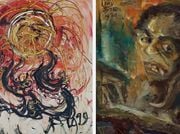Lee Man Fong was a Chinese-born Indonesian artist whose prolific output of landscape, still life, and figurative paintings contributed to the development of a unique visual language for postcolonial Southeast Asian art.
Read MoreBorn in Guangzhou, Lee spent his formative years in Singapore and moved to Jakarta in the early 1930s, where he worked for the Dutch printing company Kolff. Lee studied the Chinese Lingnan style of brush painting and oil painting. In 1936, he became the first non-Dutch artist to exhibit with the Dutch East Indies Association in Batavia.
In 1949, Lee received a Malino scholarship to study in the Netherlands for three years. This period had a significant impact on Lee's work, as historic Dutch art came to influence his execution of style and narrative. Lee gained recognition and went on to exhibit in Paris, Amsterdam, and the Hague. He returned to Indonesia in 1952.
Lee led the Yinhua Meishu Xiehui (Society of Chinese Artists in Indonesia) from 1955 to 1961 and worked as a palace artist for President Sukarno for the following five years. After the fall of Sukarno in 1967, Lee moved to Singapore. There, he befriended Chinese-born Singaporean artist Liu Kang, an early pioneer of the Nanyang style—known for its merging of elements of Chinese ink painting and western Modernism—that Lee also adopted.
The artist returned to Jakarta in 1986, where he lived until his death in 1988.
Lee worked with a range of mediums encompassing oil and ink on masonite board, paper, and canvas. He hybridised stylistic elements of traditional Chinese ink painting with western modernism, drawing on a broad range of influences that include 17th-century Dutch genre painting and the Nanyang style.
Animals were frequently the subject of Lee's works, in both standalone paintings and wider scenes or portraits. The artist painted domestic and wild creatures including doves, horses, chickens, dogs, and cats. Lee produced numerous paintings of goldfish, a significant symbol in Chinese culture that represents abundance, prosperity, and wealth. Fifteen Goldfish(c. 1940s) exemplifies the artist's handling of the brush, manipulating oil paint into differing degrees of opacity so that the work appears at first sight like an ink painting. Executed in gestural yet delicate brushstrokes, Lee's goldfish emulates a sense of movement and transience. Lee integrates the pale surface of the board to depict light and shadow, and renders surrounding underwater fauna in ghostly monochrome.
In Sepasang Ikan Mas Koki (Two Goldfish) (c. 1960s), Lee pays greater attention to the pair of goldfish, with oils applied more thickly to achieve greater tonal variance in their orange-pink fins, scales, and bulbous eyes.
Lee often painted Indonesian landscapes. The oil painting Cliff (Uluwatu) presents a view of a high coastal cliff with a pagoda at its edge, but with the appearance of a monochromatic ink painting. The unusual warped perspective heightens the grand sense of scale and beauty of the landscape. A headland in Indonesia (1939) differs slightly in its execution, with the thick, impasto rendering of the coastal setting recalling post-impressionist landscapes.
Lee was perhaps most known for his observations of daily life and cultural traditions in Indonesia. Within these he experimented with a vast range of painterly styles, from detailed brushstrokes and defined forms to looser, impressionistic applications of paint.
Capturing people engaged in work and social activities, Lee translated the bustling life of Indonesian and Southeast Asian people into compositions ranging from elegant singular portraits to large-scale tableaus. Lee often revisited archetypes of the Balinese dancer or rojak seller to illustrate multiple dimensions of a narrative, and construct multifaceted cultural identities.
Bali Life (1962–64) shows a complex snapshot of rituals within a Balinese banjar or community in sepia-tinged opulence, with men, women, and children gathered in an embellished outdoor setting. The later Bali Life (1974) depicts a group of Balinese women engaged in domestic labour, with labourers visible in the background.
Lee's works are held in major public collections, including the Oei Hong Djien (OHD) Museum in Indonesia and the National Gallery Singapore.
Misong Kim | Ocula | 2022




